|


|
|
|
Click to visit the
Official Town Site
|
|
|
|
|
|
General News: Visit the Peaceable Kingdom in the Holidays
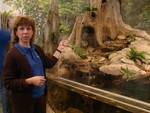
|
| Curator Pam Golben explains the estuary habitat |
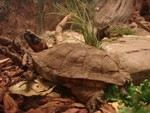
|
| Home of the wood turtle, |
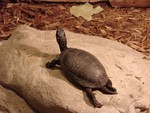
|
| the spotted turtle, |
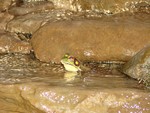
|
| and a frog. |
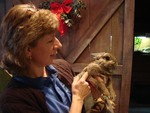
|
| The rabbit is a favorite at Meet the Animals |
December 19, 2007
If you are looking for a peaceful pastime during this hectic holiday season, take your children or grandchild in hand and come over to meet the animals at the Hudson Highlands Nature Museum in Cornwall-on-Hudson.
Visitors are welcomed to the museum’s Wildlife Education Center on the Boulevard every day after Christmas, from December 26-30, to explore the new Living Hudson Exhibit where young children can peer through large windows to pick out the different turtle, fish and frog species that live there.
Curator Pam Golben and assistant Jim Farkas can explain the differences between the painted turtle, which spends most of its time in the water, and the spotted turtle, which lounges in the water’s shallow edges. You may also see a frog or the wood turtle, which prefers to live among the roots of an old tree truck.
The very real-looking tree trunk was built and designed by Gregory George, owner of PetraWorks. The new exhibit was funded by the NYS Hudson River Estuary Program and the Hudson River Improvement fund.
From the woodlands, the living exhibit follows the water along a stream and a waterfall, where blacknose dace, catfish, and schools of smaller fish swim around. The stream spills into a replica of the Hudson estuary, a mixture of fresh and saltwater, where you can see striped bass, shiners, and perch. If you look closely, you may spot the tessilated dart, a rather pre-historic looking fish that walks on its fins.
The museum’s attractions include more than aquatic wildlife. Visitors will see the sleepy opposum, several snakes, a great horned owl and ring-neck dove, which resembles the native mourning dove. When you see the American crow perched high in its cage, be sure to say hello and don’t be surprised if the black bird responds crisply, “hello.”
Pam Golben explains that the crow learned to speak while the pet of a well-meaning owner who didn’t realize that once a wild bird or animal is adopted by humans, it can no longer survive in the wild. She says that the museum only keeps animals that could not be released into their native environment. If you find an injured animal in the wild, she advises, call a wildlife rehabilitator who can help the animal socialize with members of its own species, not humans.
If you time your visit right, you may get to enjoy the Meet the Animals program, which is held every Saturday and Sunday at 2:30 p.m., and, this year, in the days following Christmas. Visitors can see some of the animals – like the rabbit and owls -- close up and learn about their habits and habitats.
You can also test your knowledge about the animals, plants and gems that have been chosen as the state symbols of New York. An example of each is on display at the Museum. If you think you know the name of the state flower, click here to find out if you are right.
Curator Golben also suggests that visitors may want to sponsor an animal in the museum’s care. A donation will cover the cost of taking care of the animal, its foods, special, medicines, and enrichment of it environment, like toys for the opposum to chew on or for the rabbit to play with in its cage.
Golben estimates that the cost of caring for each animals runs into the thousands of dollars. They are weighed and visited by a veterinarian each month. Beaks and nails are trimmed and their animals are exercised. They get special diets and supplements to keep them healthy.
It is a bigger job than the casual visitor realizes, Golben says, and their true beauty lies in the opportunity they give visitors to experience the world of nature up close.
To learn more about the Hudson Highlands Nature Museum, or to sponsor an animal, visit www.museumhudsonhighlands.org.
Comments:
No comments have been posted.
Add a Comment:
Please signup or login to add a comment.
|
 |
|
|
|